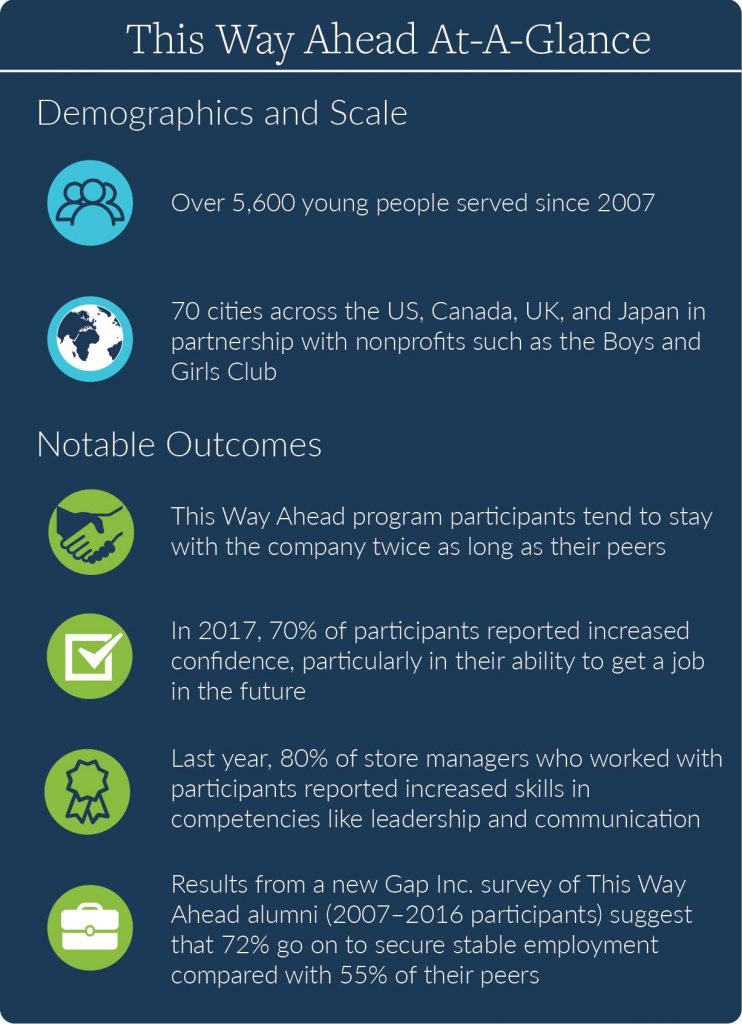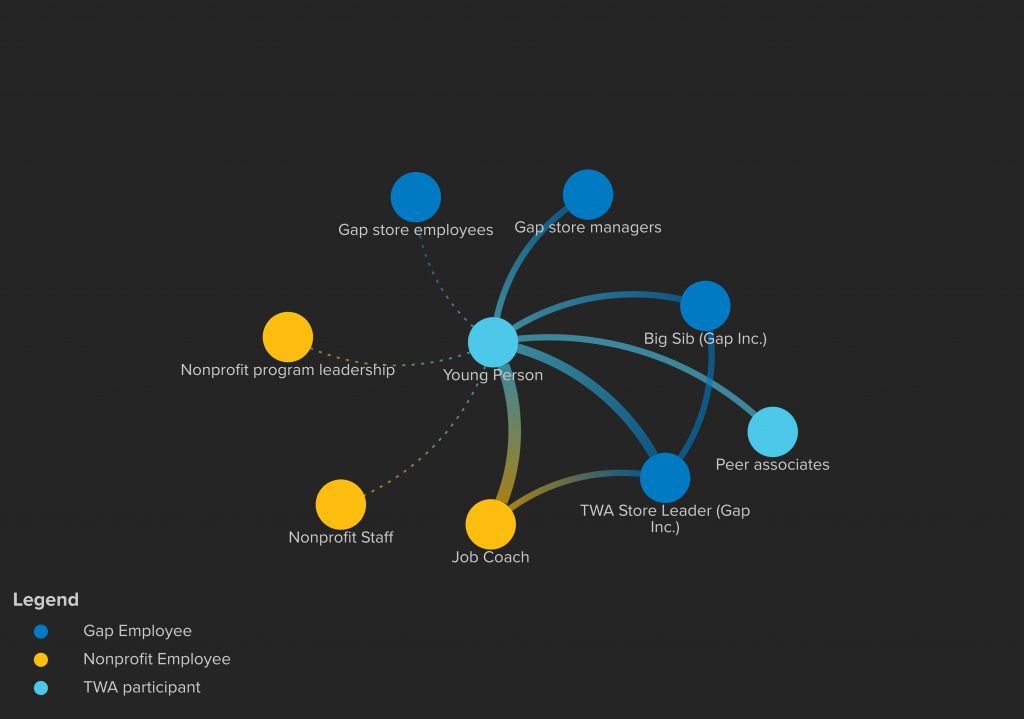Students need relationships to get by and to get ahead. But all too often in our education system, relationships are treated as inputs to learning, rather than outcomes in their own right. We’re offering in-depth profiles of programs that are flipping that script and deliberately designing models to deepen and diversify students’ networks. This is the fourth piece in our Who You Know in Action blog series. Read the first piece here, the second piece here, and the third piece here.
This blog is co-authored with Charlotte Peyser.
Read most youth development literature today and the notion that a web of support drives healthy development is nearly ubiquitous. Although a single, strong ‘anchor relationship’ is vital, an individual mentor or family member alone may not suffice. Rather, research consistently shows that having access to an interconnected web of supportive relationships is optimal for young people to get by and to thrive.
But enter most rooms in which employers are talking about recruiting and training first-time employees and a different—albeit related—set of conversations is afoot. Complaints that prospective candidates lack ‘soft skills’ or industry-specific ‘baseline skills’ abound. Education institutions are increasingly told by industry that young people aren’t graduating with the skills they need to persist and succeed in jobs.
Comparing youth development research and employer demand, there’s a disconnect between the skills employers say they want and the supports young people may need to get there. This disconnect may be even more profound when it comes to recruiting young people from low-income communities. Students from low-income communities often have fewer inroads to the knowledge economy, and fewer opportunities to practice hard and soft skills that their more affluent peers tend to access through high-cost extracurriculars or high-touch internships acquired through inherited networks.
But there’s one ingredient that can offer the supports young people need to develop the skills employers want: relationships. As part of our Who You Know in Action series, we recently took a closer look at one employer that’s proving out the power of investing in webs of support to drive skill development and retain diverse talent.

This Way Ahead
Gap Inc.’s This Way Ahead program, founded in 2007, seeks to place 16-24-year-olds facing barriers to employment in engaging first jobs that will serve as foundations for successful careers. By design, the program embraces the fundamentals of youth development—and partners with local workforce experts that are preparing young people to apply for and secure jobs—to shore up a web of support around young recruits. These relationships are not in lieu of actual training; instead, an array of supportive relationships complement and reinforce the very sorts of hard and soft skills training that Gap Inc. employees need.
This Way Ahead places young people—that it calls ‘associates’—in first jobs in Gap Inc. stores (Old Navy, Gap, Banana Republic, and Athleta) and distribution centers. By partnering with local and regional nonprofit organizations already dedicated to providing personal and professional development opportunities for underserved youth, This Way Ahead pairs prospective associates with experts in youth development who provide ‘anchor’ caring relationships. From there, This Way Ahead fills in the rest of a ‘web of support’ with volunteers, supervisors, and near-peer ‘big sibs’ from their stores. This approach, in turn, facilitates new peer and employer networks for young people to rely on as they apply for, enter into and, ideally, sustain gainful employment. On average, alumni stay at the company twice as long as their peers. These associates tend to keep the same manager and develop a strong network within their store.
Who plays what role in the web of support?
Many companies, of course, offer some breed of onboarding experiences, group professional development, and assigned mentors to support new employees. But Gap Inc.’s model stands out both in its deliberate partnership with community organizations and the distinct but connected roles employees play to shore up a web of support around young associates. These roles include:
- Job Coaches. Job coaches are employees of local nonprofits with whom Gap Inc. partners, and offer the strongest supportive tie in This Way Ahead’s relationship model. These nonprofits typically specialize in workforce development programming. As partners with This Way Ahead, they offer job training, during which Job Coaches are responsible for training a cohort of young people. Job Coaches help young people make an informed choice about the specific brand within the Gap family of stores (Old Navy, Gap, Athleta, Banana Republic) where they would like to apply. Throughout the application process and work experience, Job Coaches provide a key lifeline to young people as they encounter the challenges of a first job: they have regular check-ins with young people through phone calls, texts, emails, and in-person meetings.
- Gap Inc. Volunteers. During the training, Gap Inc. store employees visit with prospective associates at the nonprofit partner site to share what they do, and facilitate activities with the young people, including mock interviews. After each interview, Job Coaches and Gap volunteers provide constructive feedback to young people. In some cases, the Gap Inc. volunteer who facilitates a mock interview could be the person to interview the young person for the actual associate position. Young people also have the opportunity to meet volunteers when attending site visits at stores that the nonprofit partner helps to coordinate.
- Gap Inc. Store Managers. When This Way Ahead job training is complete, young people apply for a paid position at their desired store. Store managers interview the prospective associates—and for those young people accepted, this initial interaction is the basis for a sustained connection between associate and manager. If interviews do not go well, This Way Ahead encourages managers to provide feedback to young people regarding their job choices.
- This Way Ahead Store Leaders. Store leaders are Gap Inc. store employees specifically responsible for managing the This Way Ahead associates in their store. There is typically one Store Leader per store. Although the Store Leader is technically a supervisor, This Way Ahead offers trainings to ensure that Store Leaders are equipped to support associates’ needs beyond professional supervision. For example, the program connects Gap Inc.’s existing unconscious bias training to how Store Leaders work with This Way Ahead associates. Store Leaders also have a direct line to nonprofit Job Coaches so they can problem-solve together if things are not going smoothly. This Way Ahead sees this leader as first and foremost a coach for new associates. “We are intentional about encouraging leaders to have ongoing coaching conversations, be it at the beginning of a shift to review the associate’s focus for the day, or at the end to reflect on wins or opportunities for the next shift,” said Tes Cohen, Manager of Community Partnerships at Gap, Inc. “Store Leaders are dedicated to seeing and unleashing the potential in every young person. They don’t shy away from giving constructive feedback that enable youth to learn and grow.”
- This Way Ahead Big Sibs. Although connecting with managers and Store Leaders offer new associates access to guidance, near-peer mentors can offer lower-stakes, more relatable advice. A Big Sib is a Gap Inc. store employee who is usually responsible for one to two associates in the store and acts as the number one point of contact for all questions and concerns that may arise. An associate asks her Big Sib about anything she might not want to ask her manager (i.e. dress code or professional etiquette). The Big Sib is encouraged to check in with associates during scheduled breaks and to specifically ask what’s going well and what is most challenging. The Big Sib is also encouraged to touch base with the This Way Ahead leader to keep him/her apprised of the associate’s progress and to flag any concerns.
- This Way Ahead Peers. This Way Ahead has discovered that other young people going through the program are critical social assets to associates. This Way Ahead urges stores to hire more than one associate to avoid feelings of isolation or “other-ness” that may occur in a new work environment.

These connections, as one This Way Ahead alum that we interviewed noted, can be enduring and are crucial to ongoing professional success and personal growth. The same alum stated that were it not for the mentors and friends he gained along his This Way Ahead journey, he would not have the confidence he has today. Since he graduated from This Way Ahead, he has been promoted through his store and currently serves in a managerial role. He credits his job coaches and fellow employee relationships with his continued success.
Although This Way Ahead’s model was originally designed with retail, entry-level internships in mind, at its core it’s a recruiting and training model that takes to heart the bedrock of youth development literature while also addressing the skills their associates need to succeed. This can be crucial not just in supporting young people in their first jobs, but in their careers.
The promise of combining supportive relationships with workforce training is consistent with new research from Child Trends and Brookings on Pathways to High-Quality Jobs. Researchers found that young people participating in what they dubbed “relationship-based” work-based learning correlated with greater access to high-quality jobs a decade down the line. This Way Ahead is starting to see this play out among former interns: a new Gap Inc. survey of This Way Ahead alumni (2007–2016 participants) suggests that 72% go on to secure stable employment compared with 55% of their peers. Although the researchers call for much-needed further research and action on what it means to design ‘relationship-based’ programs, at least one employer is leading the way ahead.


